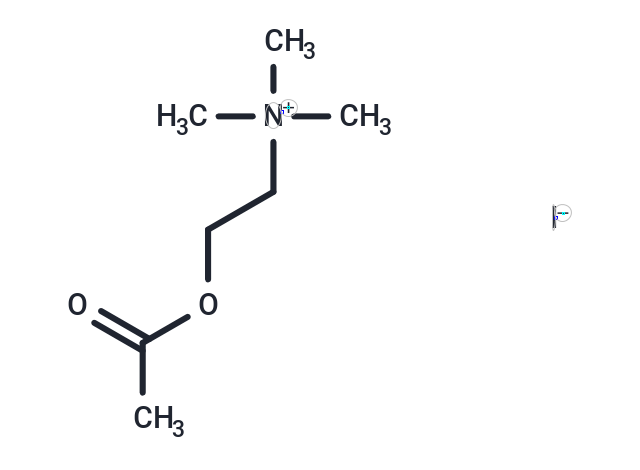Shopping Cart
- Remove All
 Your shopping cart is currently empty
Your shopping cart is currently empty

Acetylcholine iodide (Acetylcolina) is a neurotransmitter found at neuromuscular junctions, autonomic ganglia, parasympathetic effector junctions, a subset of sympathetic effector junctions, and at many sites in the central nervous system.

| Pack Size | Price | Availability | Quantity |
|---|---|---|---|
| 100 mg | $41 | In Stock | |
| 200 mg | $58 | In Stock | |
| 500 mg | $93 | In Stock | |
| 1 mL x 10 mM (in DMSO) | $45 | In Stock |
| Description | Acetylcholine iodide (Acetylcolina) is a neurotransmitter found at neuromuscular junctions, autonomic ganglia, parasympathetic effector junctions, a subset of sympathetic effector junctions, and at many sites in the central nervous system. |
| In vitro | Acetylcholine iodide (Ach) stimulated SBC3 cell proliferation, adhesion and migration toward fibronectin (Fn) in a dose-dependent manner[1]. ACh ameliorates TNF-α-induced calpain activation by decreasing p38-MAPK phosphorylation and enhancing calpastatin expression. It elicits an anti-apoptotic effect through the activation of the muscarinic ACh receptor (MAChR) and the activation of anti-oxidant systems. ACh increases cell viability and decreases TNF-α-induced apoptosis in H9c2 cells[2]. |
| In vivo | Acetylcholine can inhibit pro-inflammatory cytokine release and protect against cardiomyocyte injury[2]. |
| Cell Research | The SBC3 cells are seeded at 2000 cells/well in treated 96-well plates maintained with RPMI1640 medium containing 10% (v/v) FCS for 24 h. The medium is removed and replaced with 100 μl RPMI1640 containing 1% (v/v) ITS. The cells are incubated in serum free medium for 24 h to synchronize the cell cycle. Then another 100 μl serum-free medium containing the agonist/antagonist under investigation is added. The antagonist is added 30 min before Ach(Acetylcholine iodide). At this time, the cells in a duplicate plate are given 100 μl serum-free medium and a MTT assay is used to determine live cell numbers before treatment with the agonist/antagonist as measured by the absorbance (OD) at 550 nm/650 nm. After 24, 48 or 72 h culture, the remaining cells are assayed to yield post-agonist/antagonist cell numbers using the same method. All the experiments are performed in triplicate.(Only for Reference) |
| Alias | Acetylcolina |
| Molecular Weight | 273.11 |
| Formula | C7H16NO2·I |
| Cas No. | 2260-50-6 |
| Smiles | CC(=O)OCC[N+](C)(C)C.[I-] |
| Relative Density. | 1.4816 g/cm3 (Estimated) |
| Storage | Powder: -20°C for 3 years | In solvent: -80°C for 1 year | Shipping with blue ice. | |||||||||||||||||||||||||||||||||||
| Solubility Information | DMSO: 50 mg/mL (183.08 mM), Sonication is recommended. H2O: 33 mg/mL (120.83 mM), Sonication is recommended. | |||||||||||||||||||||||||||||||||||
Solution Preparation Table | ||||||||||||||||||||||||||||||||||||
H2O/DMSO
| ||||||||||||||||||||||||||||||||||||

Copyright © 2015-2025 TargetMol Chemicals Inc. All Rights Reserved.